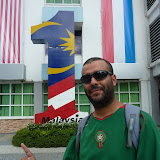Singapore : Durian and skyscrapers
We finally left Malaysia after enjoying several days in Melaka. We found ourselves again in a city staging a multicultural blend and a colonial architecture but, this time, with a dutch touch. As we are not necessarily too fond of old stones, we spent our stay sampling the spicy hybrid food from the little "Makan" (restaurants). At the Indian from around the corner, we treated ourselves to a Roti Canai : a pancake close to the Moroccan "M'semane" and served with Dal (Lentils Curry). A family Chinese kitchen served us a Laksa : noodles, tofu and sea-food bathing in a very spicy coconut milk and curry gravy. To finish with class, we had a Satay Celup, a DIY thing where you cook various type of skewers in a peanut sauce. Definitely, Melaka tasted real good.

Before heading to Indonesia, we did a stop-over in Singapore where we stayed with Bea, a Spanish girl that we had met at the Petronas Towers in Kuala Lumpur. She graciously offered to host us on a typical neighborhood of the island with its Kopitiam and its hawker center.
We also spent a nice evening with Timothée, a friend from the university, who took us away from the tourist trail to try a tasty chili-crab, a typical dish. Wearing an apron was mandatory if you did not want to say good-bye to your clothes. Then around midnight, he took us through a dodgy experiment which pictures are already on Facebook : he made us try durian. Imagine a creamy substance with a strong garlic taste and a sewer smell in your mouth. This fruit is so popular over there that it inspired the shape of the city Opera. But still, it is forbidden to take it with you on a plane or the subway.

Singapore is a pleasant Hong-Kong : greener and less claustrophobic. It is true that skyscrapers are all over the CBD but Little India, Chinatown or the colonial area around Raffles square can be quite a change of scenery. In Clark Quay, you can even move your body on Cuban or Middle eastern beats. Like in Hong-Kong, most of the population is from a Chinese origin but, as in Malaysia, English is widely spoken, making it easy to chat with the "locals".

Two full days were not enough to visit the city as we were engaged in a race against time trying to get the most of it. We like also to do things the hard way : we have forgotten to take the camera the first day. So the second day, we re-visited some places to take some shots. Unfortunately, the weather was not sunny anymore, but very foggy as in HK.
We liked Singapore even if some find it oppressive with its heavy fine policy, judicial caning and big brother surveillance.
In our case, it is our next destination that sounds challenging. A few hours before our flight to Jakarta where we planned to do some couchsurfing, our host sent us an email to cancel ...
Karim

Before heading to Indonesia, we did a stop-over in Singapore where we stayed with Bea, a Spanish girl that we had met at the Petronas Towers in Kuala Lumpur. She graciously offered to host us on a typical neighborhood of the island with its Kopitiam and its hawker center.
We also spent a nice evening with Timothée, a friend from the university, who took us away from the tourist trail to try a tasty chili-crab, a typical dish. Wearing an apron was mandatory if you did not want to say good-bye to your clothes. Then around midnight, he took us through a dodgy experiment which pictures are already on Facebook : he made us try durian. Imagine a creamy substance with a strong garlic taste and a sewer smell in your mouth. This fruit is so popular over there that it inspired the shape of the city Opera. But still, it is forbidden to take it with you on a plane or the subway.

Singapore is a pleasant Hong-Kong : greener and less claustrophobic. It is true that skyscrapers are all over the CBD but Little India, Chinatown or the colonial area around Raffles square can be quite a change of scenery. In Clark Quay, you can even move your body on Cuban or Middle eastern beats. Like in Hong-Kong, most of the population is from a Chinese origin but, as in Malaysia, English is widely spoken, making it easy to chat with the "locals".

Two full days were not enough to visit the city as we were engaged in a race against time trying to get the most of it. We like also to do things the hard way : we have forgotten to take the camera the first day. So the second day, we re-visited some places to take some shots. Unfortunately, the weather was not sunny anymore, but very foggy as in HK.
We liked Singapore even if some find it oppressive with its heavy fine policy, judicial caning and big brother surveillance.
In our case, it is our next destination that sounds challenging. A few hours before our flight to Jakarta where we planned to do some couchsurfing, our host sent us an email to cancel ...
Karim












